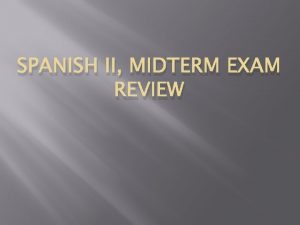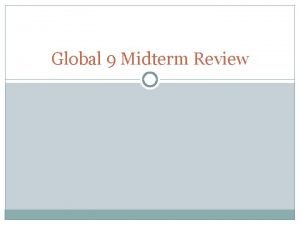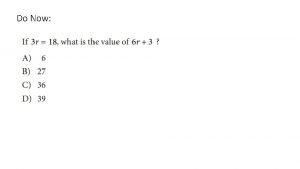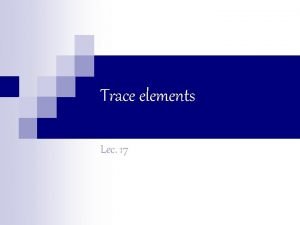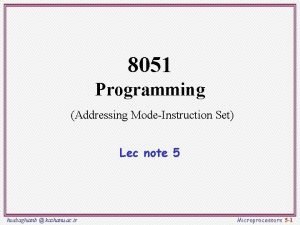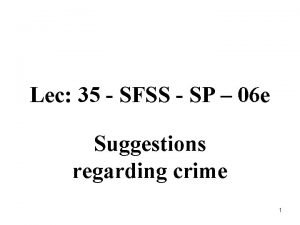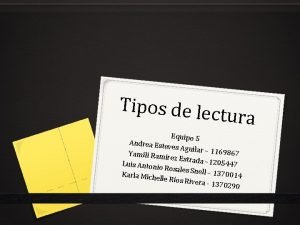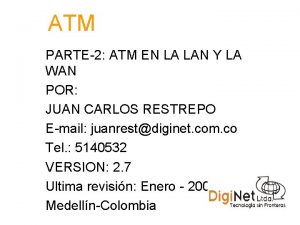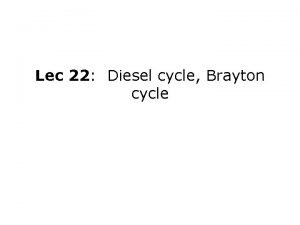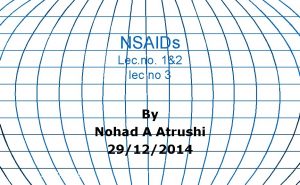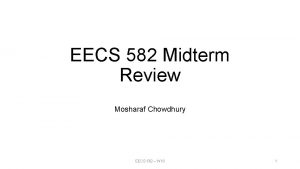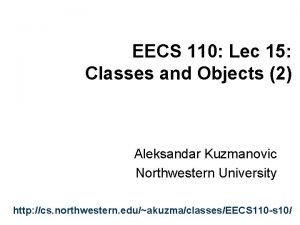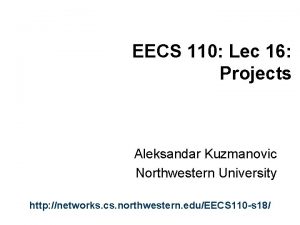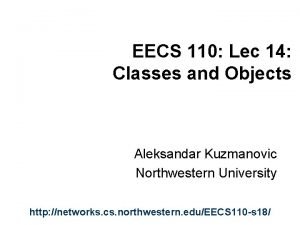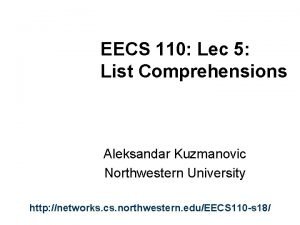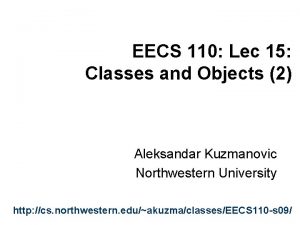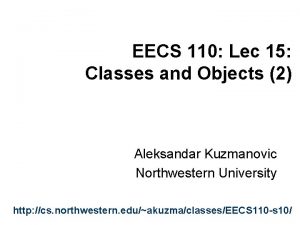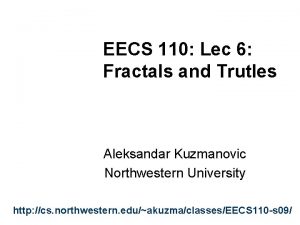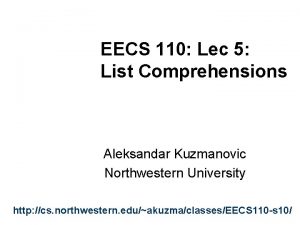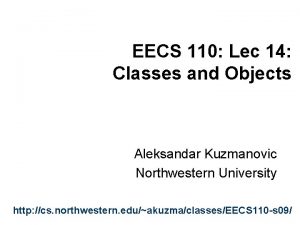EECS 110 Lec 9 Review for the Midterm





















































![def num. As( s ): if len(s) == 0: return 0 elif s[0] != def num. As( s ): if len(s) == 0: return 0 elif s[0] !=](https://slidetodoc.com/presentation_image_h2/c95266c99bf9f26ba36bb47c843a9cfc/image-54.jpg)
![def num. As( s ): if len(s) == 0: return 0 elif s[0] != def num. As( s ): if len(s) == 0: return 0 elif s[0] !=](https://slidetodoc.com/presentation_image_h2/c95266c99bf9f26ba36bb47c843a9cfc/image-55.jpg)
![def num. As( s ): if len(s) == 0: return 0 elif s[0] != def num. As( s ): if len(s) == 0: return 0 elif s[0] !=](https://slidetodoc.com/presentation_image_h2/c95266c99bf9f26ba36bb47c843a9cfc/image-56.jpg)
![def num. As( s ): if len(s) == 0: return 0 elif s[0] != def num. As( s ): if len(s) == 0: return 0 elif s[0] !=](https://slidetodoc.com/presentation_image_h2/c95266c99bf9f26ba36bb47c843a9cfc/image-57.jpg)
![def num. As( s ): if len(s) == 0: return 0 elif s[0] != def num. As( s ): if len(s) == 0: return 0 elif s[0] !=](https://slidetodoc.com/presentation_image_h2/c95266c99bf9f26ba36bb47c843a9cfc/image-58.jpg)
![def num. As( s ): if len(s) == 0: return 0 elif s[0] != def num. As( s ): if len(s) == 0: return 0 elif s[0] !=](https://slidetodoc.com/presentation_image_h2/c95266c99bf9f26ba36bb47c843a9cfc/image-59.jpg)
![def num. As( s ): if len(s) == 0: return 0 elif s[0] != def num. As( s ): if len(s) == 0: return 0 elif s[0] !=](https://slidetodoc.com/presentation_image_h2/c95266c99bf9f26ba36bb47c843a9cfc/image-60.jpg)
![def num. As( s ): if len(s) == 0: return 0 elif s[0] != def num. As( s ): if len(s) == 0: return 0 elif s[0] !=](https://slidetodoc.com/presentation_image_h2/c95266c99bf9f26ba36bb47c843a9cfc/image-61.jpg)
![def num. As( s ): if len(s) == 0: return 0 elif s[0] != def num. As( s ): if len(s) == 0: return 0 elif s[0] !=](https://slidetodoc.com/presentation_image_h2/c95266c99bf9f26ba36bb47c843a9cfc/image-62.jpg)
![def num. As( s ): if len(s) == 0: return 0 elif s[0] != def num. As( s ): if len(s) == 0: return 0 elif s[0] !=](https://slidetodoc.com/presentation_image_h2/c95266c99bf9f26ba36bb47c843a9cfc/image-63.jpg)



![def remove. A( s ): if len(s) == 0: return ' ' elif s[0] def remove. A( s ): if len(s) == 0: return ' ' elif s[0]](https://slidetodoc.com/presentation_image_h2/c95266c99bf9f26ba36bb47c843a9cfc/image-67.jpg)






![List Comprehensions (Ex. 3) >> S = [x**2 for x in range(5)] >> V List Comprehensions (Ex. 3) >> S = [x**2 for x in range(5)] >> V](https://slidetodoc.com/presentation_image_h2/c95266c99bf9f26ba36bb47c843a9cfc/image-74.jpg)
![List Comprehensions (Ex. 3) >> S = [x**2 for x in range(5)] >> V List Comprehensions (Ex. 3) >> S = [x**2 for x in range(5)] >> V](https://slidetodoc.com/presentation_image_h2/c95266c99bf9f26ba36bb47c843a9cfc/image-75.jpg)
![List Comprehensions (Ex. 3) >> S = [x**2 for x in range(5)] >> V List Comprehensions (Ex. 3) >> S = [x**2 for x in range(5)] >> V](https://slidetodoc.com/presentation_image_h2/c95266c99bf9f26ba36bb47c843a9cfc/image-76.jpg)
![List Comprehensions (Ex. 3) >> S = [x**2 for x in range(5)] >> V List Comprehensions (Ex. 3) >> S = [x**2 for x in range(5)] >> V](https://slidetodoc.com/presentation_image_h2/c95266c99bf9f26ba36bb47c843a9cfc/image-77.jpg)
![List Comprehensions (Ex. 3) >> S = [x**2 for x in range(5)] >> V List Comprehensions (Ex. 3) >> S = [x**2 for x in range(5)] >> V](https://slidetodoc.com/presentation_image_h2/c95266c99bf9f26ba36bb47c843a9cfc/image-78.jpg)
![List Comprehensions (Ex. 3) >> S = [x**2 for x in range(5)] >> V List Comprehensions (Ex. 3) >> S = [x**2 for x in range(5)] >> V](https://slidetodoc.com/presentation_image_h2/c95266c99bf9f26ba36bb47c843a9cfc/image-79.jpg)
![Question 5: Lists of Lists >> S = [[1, 2, 3], [4, 5, 6], Question 5: Lists of Lists >> S = [[1, 2, 3], [4, 5, 6],](https://slidetodoc.com/presentation_image_h2/c95266c99bf9f26ba36bb47c843a9cfc/image-80.jpg)
![Lists of Lists >> S = [[1, 2, 3], [4, 5, 6], [7, 8, Lists of Lists >> S = [[1, 2, 3], [4, 5, 6], [7, 8,](https://slidetodoc.com/presentation_image_h2/c95266c99bf9f26ba36bb47c843a9cfc/image-81.jpg)
![Lists of Lists >> S = [[1, 2, 3], [4, 5, 6], [7, 8, Lists of Lists >> S = [[1, 2, 3], [4, 5, 6], [7, 8,](https://slidetodoc.com/presentation_image_h2/c95266c99bf9f26ba36bb47c843a9cfc/image-82.jpg)
![Lists of Lists >> S = [[1, 2, 3], [4, 5, 6], [7, 8, Lists of Lists >> S = [[1, 2, 3], [4, 5, 6], [7, 8,](https://slidetodoc.com/presentation_image_h2/c95266c99bf9f26ba36bb47c843a9cfc/image-83.jpg)
![Lists of Lists >> S = [[1, 2, 3], [4, 5, 6], [7, 8, Lists of Lists >> S = [[1, 2, 3], [4, 5, 6], [7, 8,](https://slidetodoc.com/presentation_image_h2/c95266c99bf9f26ba36bb47c843a9cfc/image-84.jpg)
![Lists of Lists >> S = [[1, 2, 3], [4, 5, 6], [7, 8, Lists of Lists >> S = [[1, 2, 3], [4, 5, 6], [7, 8,](https://slidetodoc.com/presentation_image_h2/c95266c99bf9f26ba36bb47c843a9cfc/image-85.jpg)
![Lists of Lists >> S = [[1, 2, 3], [4, 5, 6], [7, 8, Lists of Lists >> S = [[1, 2, 3], [4, 5, 6], [7, 8,](https://slidetodoc.com/presentation_image_h2/c95266c99bf9f26ba36bb47c843a9cfc/image-86.jpg)
![Lists of Lists >> S = [[1, 2, 3], [4, 5, 6], [7, 8, Lists of Lists >> S = [[1, 2, 3], [4, 5, 6], [7, 8,](https://slidetodoc.com/presentation_image_h2/c95266c99bf9f26ba36bb47c843a9cfc/image-87.jpg)

![Representing the Pixels in a Picture pixels: [ [(3, 100), (3, 110)], [(3, 10, Representing the Pixels in a Picture pixels: [ [(3, 100), (3, 110)], [(3, 10,](https://slidetodoc.com/presentation_image_h2/c95266c99bf9f26ba36bb47c843a9cfc/image-89.jpg)
![Tuples vs. Lists [ [(3, 100), (3, 110)], [(3, 10, 200), (10, 110, 290)] Tuples vs. Lists [ [(3, 100), (3, 110)], [(3, 10, 200), (10, 110, 290)]](https://slidetodoc.com/presentation_image_h2/c95266c99bf9f26ba36bb47c843a9cfc/image-90.jpg)







- Slides: 97

EECS 110: Lec 9: Review for the Midterm Exam Aleksandar Kuzmanovic Northwestern University http: //cs. northwestern. edu/~akuzma/classes/EECS 110 -s 09/

General Info Wednesday, April 29, 10 -11: 30 am, Annenberg Hall G 15 To be done individually Closed book One 8. 5” by 11” sheet of paper permitted Please do not discuss the exam with others until everyone has taken it. There are six questions. Each question is worth 20 points. Hence, you can acquire 120 points in total. Those who get > 90 points will get an A. Those who get >80 points and <90 points will get a B, etc. 2

Midterm Exam 6 questions: 1. What Python would say? 2. Functions 3. Recursion 4. List comprehensions 5. Lists of lists 6. Bugs 3

Question 1: What Python Would Say? >> x = 41 >> y = x + 1 >> x ? ?

What Python Would Say? >> x = 41 >> y = x + 1 >> x 41

What Python Would Say? >> >> >> 41 >> ? ? x = 41 y = x + 1 x y

What Python Would Say? >> >> >> 41 >> 42 x = 41 y = x + 1 x y

What Python Would Say? >> >> >> 41 >> 42 >> >> ? ? x = 41 y = x + 1 x y x = x + y x

What Python Would Say? >> >> >> 41 >> 42 >> >> 83 x = 41 y = x + 1 x y x = x + y x

What Python Would Say? >> >> >> 41 >> 42 >> >> 83 >> ? ? x = 41 y = x + 1 x y x = x + y x y

What Python Would Say? >> >> >> 41 >> 42 >> >> 83 >> 42 x = 41 y = x + 1 x y x = x + y x y

Python (numeric) data types Dominant float long int bool Recessive What will these results be? 1. 0 / 5 10**100 - 10**100 1 / 5 41 + True

% the “mod” operator x%y returns the remainder when x is divided by y 7 % 3 8 % 3 9 % 3 16 % 7 x%2 == 0 For what values of x are these True? x%2 == 1 x%4 == 0

string functions str len + * str(42) returns '42' converts input to a string len('42') returns 2 returns the string’s length 'XL' + 'II' returns 'XLII' 'VI'*7 returns 'VIVIVIVI' concatenates strings repeats strings

String surgery s = ’northwestern university' 0 1 2 3 4 5 6 7 8 9 s[ ] 10 11 12 13 14 15 16 17 18 19 20 21 22 indexes into the string, returning a one-character string index s[0] returns 'n' Read "s-of-zero" or "s-zero" s[12]returns S[ ] returns 'h' Which index returns 'e'? s[len(s)] returns python != English

String surgery s = ’northwestern university' 0 1 2 3 4 5 6 7 8 9 s[ ] 10 11 12 13 14 15 16 17 18 19 20 21 22 indexes into the string, returning a one-character string index s[0] returns 'n' s[12]returns ' ' S[ ] returns 'h' Read "s-of-zero" or "s-zero" Which index returns 'e'? s[len(s)] returns python != English

String surgery s = ’northwestern university' 0 1 2 3 4 5 6 7 8 9 s[ ] 10 11 12 13 14 15 16 17 18 19 20 21 22 indexes into the string, returning a one-character string index s[0] returns 'n' s[12]returns ' ' S[4] returns 'h' Read "s-of-zero" or "s-zero" Which index returns 'e'? s[len(s)] returns python != English

String surgery s = ’northwestern university' 0 1 2 3 4 5 6 7 8 9 s[ ] 10 11 12 13 14 15 16 17 18 19 20 21 22 indexes into the string, returning a one-character string index s[0] returns 'n' s[12]returns ' ' S[4] returns 'h' s[len(s)] returns Read "s-of-zero" or "s-zero" Which index returns 'e'? ERROR python != English

Slicing s = ‘northwestern university' 0 1 2 3 4 5 6 7 8 9 s[ : ] 10 11 12 13 14 15 16 17 18 19 20 21 22 slices the string, returning a substring What's going on here? s[0: 5] returns 'north' s[5: 9] returns 'west' s[17: ] returns 'ersity' s[: ] returns 'northwestern university'

Slicing s = ‘northwestern university' 0 1 2 3 4 5 6 7 8 9 s[ : ] 10 11 12 13 14 15 16 17 18 19 20 21 22 slices the string, returning a substring the first index is the first character of the slice the second index is ONE AFTER the last character s[0: 5] returns 'north' a missing index means the end of the string s[5: 9] returns 'west' s[17: ] returns 'ersity' s[: ] returns 'northwestern university'

Skip-slicing s = ‘northwestern university' 0 1 2 3 4 5 6 7 8 9 s[ : : ] 10 11 12 13 14 15 16 17 18 19 20 21 22 skip-slices, returning a subsequence third index is the "stride" length it defaults to 1 s[0: 8: 2] returns 'nrhe' What skip-slice returns What does this return? 'ruv' s[1: : 6]

Skip-slicing s = ‘northwestern university' 0 1 2 3 4 5 6 7 8 9 s[ : : ] 10 11 12 13 14 15 16 17 18 19 20 21 22 skip-slices, returning a subsequence third index is the "stride" length it defaults to 1 s[0: 8: 2] returns 'nrhe' What skip-slice returns What does this return? 'ruv' s[1: : 6] s[10: 17: 3]

Skip-slicing s = ‘northwestern university' 0 1 2 3 4 5 6 7 8 9 s[ : : ] 10 11 12 13 14 15 16 17 18 19 20 21 22 skip-slices, returning a subsequence third index is the "stride" length it defaults to 1 s[0: 8: 2] returns 'nrhe' What skip-slice returns What does this return? 'ruv' s[10: 17: 3] s[1: : 6] 'osus'

Lists ~ Strings of anything Commas separate elements. L = [ 3. 14, [2, 40], 'third', 42 ] Square brackets tell python you want a list. len(L) L[0] Indexing: could return a different type Slicing: always returns the same type L[0: 1] How could you extract from L 'hi'

Lists ~ Strings of anything Commas separate elements. L = [ 3. 14, [2, 40], 'third', 42 ] Square brackets tell python you want a list. len(L) 4 L[0] Indexing: could return a different type Slicing: always returns the same type L[0: 1] How could you extract from L 'hi'

Lists ~ Strings of anything Commas separate elements. L = [ 3. 14, [2, 40], 'third', 42 ] Square brackets tell python you want a list. len(L) L[0] 4 3. 14 Indexing: could return a different type Slicing: always returns the same type L[0: 1] How could you extract from L 'hi'

Lists ~ Strings of anything Commas separate elements. L = [ 3. 14, [2, 40], 'third', 42 ] Square brackets tell python you want a list. len(L) L[0] 4 3. 14 Indexing: could return a different type Slicing: always returns the same type L[0: 1] [3. 14] How could you extract from L 'hi'

Lists ~ Strings of anything Commas separate elements. L = [ 3. 14, [2, 40], 'third', 42 ] Square brackets tell python you want a list. len(L) L[0] 4 3. 14 Indexing: could return a different type Slicing: always returns the same type L[0: 1] [3. 14] How could you extract from L 'hi' L[2][1: 3]

The in thing >>> 3*'i' in 'alien' False >>> 'i' in 'team' False >>> 'cs' in 'physics' True >>> ‘sleep' not in ‘EECS 110' True >>> 42 in [41, 42, 43] True >>> 42 in [ [42], '42' ] False a little bit different for lists…

Question 2: Functioning in Python Some basic, built-in functions: abs bool absolute value float max min of lists sum range round these change data from one type to another long list creates lists str only as accurately as it can! The most important: int help dir

Functioning in Python # my own function! def dbl( x ): """ returns double its input, x """ return 2*x keywords Some of Python's baggage… def starts the function return stops it immediately and sends back the return value Comments They begin with # Docstrings They become part of python's built-in help system! With each function be sure to include one that (1) describes overall what the function does, and (2) explains what the inputs mean/are

How functions work… def demo(x): return x + f(x) def f(x): return 11*g(x) + g(x/2) def g(x): return -1 * x What is demo(-4) ?

How functions work… def demo(x): return x + f(x) def f(x): return 11*g(x) + g(x/2) def g(x): return -1 * x What is demo(-4) ? demo x = -4 return -4 + f(-4)

How functions work… def demo(x): return x + f(x) def f(x): return 11*g(x) + g(x/2) demo x = -4 return -4 + f(-4) f def g(x): return -1 * x What is demo(-4) ? x = -4 return 11*g(x) + g(x/2)

How functions work… def demo(x): return x + f(x) def f(x): return 11*g(x) + g(x/2) demo x = -4 return -4 + f(-4) f def g(x): return -1 * x x = -4 return 11*g(x) + g(x/2) These are different x's ! What is demo(-4) ?

How functions work… def demo(x): return x + f(x) def f(x): return 11*g(x) + g(x/2) demo x = -4 return -4 + f(-4) f x = -4 return 11*g(-4) + g(-4/2) def g(x): return -1 * x g What is demo(-4) ? x = -4 return -1. 0 * x

How functions work… def demo(x): return x + f(x) def f(x): return 11*g(x) + g(x/2) demo x = -4 return -4 + f(-4) f x = -4 return 11* 4 def g(x): return -1 * x g What is demo(-4) ? x = -4 return -1 * -4 + g(-4/2) 4

How functions work… def demo(x): return x + f(x) def f(x): return 11*g(x) + g(x/2) demo x = -4 return -4 + f(-4) f def g(x): return -1. 0 * x What is demo(-4) ? x = -4 return 11* 4 + g(-4/2)

How functions work… def demo(x): return x + f(x) def f(x): return 11*g(x) + g(x/2) demo x = -4 return -4 + f(-4) f x = -4 return 11* 4 def g(x): return -1 * x g What is demo(-4) ? x = -2 return -1 * -2 + g(-4/2) 2

How functions work… def demo(x): return x + f(x) def f(x): return 11*g(x) + g(x/2) demo x = -4 return -4 + f(-4) f def g(x): return -1. 0 * x What is demo(-4) ? x = -4 return 11* 4 + 2

How functions work… def demo(x): return x + f(x) def f(x): return 11*g(x) + g(x/2) demo x = -4 return -4 + f(-4) f def g(x): return -1. 0 * x What is demo(-4) ? x = -4 return 11* 4 + 2 46

How functions work… def demo(x): return x + f(x) def f(x): return 11*g(x) + g(x/2) demo x = -4 return -4 + def g(x): return -1. 0 * x What is demo(-4) ? 42 46

Question 3: Recursion The recursion mantra:

Recursion The recursion mantra: def fac(N): You handle the base case – the easiest possible case to think of! if N <= 1: return 1 Recursion does almost all of the rest of the problem! else: return N * fac(N-1)

Example 1: Designing num. As How many A’s are in a particular string? antarctica gattaca Base Case: Recursive Step:

num. As How many A’s are in a particular string? antarctica gattaca Base Case: Recursive Step: Think about the SIMPLEST POSSIBLE case! Do ONLY ONE STEP, and let recursion do the rest…

num. As How many A’s are in a particular string? antarctica gattaca Base Case: Recursive Step: when there are no letters, there are ZERO A’s

num. As How many A’s are in a particular string? antarctica gattaca Base Case: when there are no letters, there are ZERO A’s if the first letter is NOT an A, the answer is just ______ Recursive Step:

num. As How many A’s are in a particular string? antarctica gattaca Base Case: Recursive Step: when there are no letters, there are ZERO A’s if the first letter is NOT an A, the answer is just the number of A’s in the rest of the string

num. As How many A’s are in a particular string? antarctica gattaca Base Case: Recursive Step: when there are no letters, there are ZERO A’s if the first letter is NOT an A, the answer is just the number of A’s in the rest of the string if the first letter IS an A, the answer is just ______

num. As How many A’s are in a particular string? antarctica gattaca Base Case: Recursive Step: when there are no letters, there are ZERO A’s if the first letter is NOT an A, the answer is just the number of A’s in the rest of the string if the first letter IS an A, the answer is just 1 + the number of A’s in the rest of the string

num. As def num. As( s ): if len(s) == 0: return 0 elif s[0] != 'a': return num. As(s[1: ]) elif s[0] == 'a': return 1+num. As(s[1: ]) Base Case: Recursive Step: when there are no letters, there are ZERO A’s if the first letter is NOT an A, the answer is just the number of A’s in the rest of the string if the first letter IS an A, the answer is just 1 + the number of A’s in the rest of the string

num. As def num. As( s ): if len(s) == 0: return 0 elif s[0] != 'a': return num. As(s[1: ]) elif s[0] == 'a': return 1+num. As(s[1: ]) Base Case: Recursive Step: when there are no letters, there are ZERO A’s if the first letter is NOT an A, the answer is just the number of A’s in the rest of the string if the first letter IS an A, the answer is just 1 + the number of A’s in the rest of the string
![def num As s if lens 0 return 0 elif s0 def num. As( s ): if len(s) == 0: return 0 elif s[0] !=](https://slidetodoc.com/presentation_image_h2/c95266c99bf9f26ba36bb47c843a9cfc/image-54.jpg)
def num. As( s ): if len(s) == 0: return 0 elif s[0] != 'a': return num. As(s[1: ]) elif s[0] == 'a': return 1+num. As(s[1: ]) num. As('gattaca')
![def num As s if lens 0 return 0 elif s0 def num. As( s ): if len(s) == 0: return 0 elif s[0] !=](https://slidetodoc.com/presentation_image_h2/c95266c99bf9f26ba36bb47c843a9cfc/image-55.jpg)
def num. As( s ): if len(s) == 0: return 0 elif s[0] != 'a': return num. As(s[1: ]) elif s[0] == 'a': return 1+num. As(s[1: ]) num. As('gattaca') num. As('attaca')
![def num As s if lens 0 return 0 elif s0 def num. As( s ): if len(s) == 0: return 0 elif s[0] !=](https://slidetodoc.com/presentation_image_h2/c95266c99bf9f26ba36bb47c843a9cfc/image-56.jpg)
def num. As( s ): if len(s) == 0: return 0 elif s[0] != 'a': return num. As(s[1: ]) elif s[0] == 'a': return 1+num. As(s[1: ]) num. As('gattaca') num. As('attaca') 1+num. As('ttaca')
![def num As s if lens 0 return 0 elif s0 def num. As( s ): if len(s) == 0: return 0 elif s[0] !=](https://slidetodoc.com/presentation_image_h2/c95266c99bf9f26ba36bb47c843a9cfc/image-57.jpg)
def num. As( s ): if len(s) == 0: return 0 elif s[0] != 'a': return num. As(s[1: ]) elif s[0] == 'a': return 1+num. As(s[1: ]) num. As('gattaca') num. As('attaca') 1+num. As('taca')
![def num As s if lens 0 return 0 elif s0 def num. As( s ): if len(s) == 0: return 0 elif s[0] !=](https://slidetodoc.com/presentation_image_h2/c95266c99bf9f26ba36bb47c843a9cfc/image-58.jpg)
def num. As( s ): if len(s) == 0: return 0 elif s[0] != 'a': return num. As(s[1: ]) elif s[0] == 'a': return 1+num. As(s[1: ]) num. As('gattaca') num. As('attaca') 1+num. As('taca') 1+num. As('aca')
![def num As s if lens 0 return 0 elif s0 def num. As( s ): if len(s) == 0: return 0 elif s[0] !=](https://slidetodoc.com/presentation_image_h2/c95266c99bf9f26ba36bb47c843a9cfc/image-59.jpg)
def num. As( s ): if len(s) == 0: return 0 elif s[0] != 'a': return num. As(s[1: ]) elif s[0] == 'a': return 1+num. As(s[1: ]) num. As('gattaca') num. As('attaca') 1+num. As('taca') 1+num. As('aca') 1+1+num. As('ca')
![def num As s if lens 0 return 0 elif s0 def num. As( s ): if len(s) == 0: return 0 elif s[0] !=](https://slidetodoc.com/presentation_image_h2/c95266c99bf9f26ba36bb47c843a9cfc/image-60.jpg)
def num. As( s ): if len(s) == 0: return 0 elif s[0] != 'a': return num. As(s[1: ]) elif s[0] == 'a': return 1+num. As(s[1: ]) num. As('gattaca') num. As('attaca') 1+num. As('taca') 1+num. As('aca') 1+1+num. As('a')
![def num As s if lens 0 return 0 elif s0 def num. As( s ): if len(s) == 0: return 0 elif s[0] !=](https://slidetodoc.com/presentation_image_h2/c95266c99bf9f26ba36bb47c843a9cfc/image-61.jpg)
def num. As( s ): if len(s) == 0: return 0 elif s[0] != 'a': return num. As(s[1: ]) elif s[0] == 'a': return 1+num. As(s[1: ]) num. As('gattaca') num. As('attaca') 1+num. As('taca') 1+num. As('aca') 1+1+num. As('a') 1+1+1+num. As('')
![def num As s if lens 0 return 0 elif s0 def num. As( s ): if len(s) == 0: return 0 elif s[0] !=](https://slidetodoc.com/presentation_image_h2/c95266c99bf9f26ba36bb47c843a9cfc/image-62.jpg)
def num. As( s ): if len(s) == 0: return 0 elif s[0] != 'a': return num. As(s[1: ]) elif s[0] == 'a': return 1+num. As(s[1: ]) num. As('gattaca') num. As('attaca') 1+num. As('taca') 1+num. As('aca') 1+1+num. As('a') 1+1+1+num. As('') 1+1+1+0
![def num As s if lens 0 return 0 elif s0 def num. As( s ): if len(s) == 0: return 0 elif s[0] !=](https://slidetodoc.com/presentation_image_h2/c95266c99bf9f26ba36bb47c843a9cfc/image-63.jpg)
def num. As( s ): if len(s) == 0: return 0 elif s[0] != 'a': return num. As(s[1: ]) elif s[0] == 'a': return 1+num. As(s[1: ]) num. As('gattaca') num. As('attaca') 1+num. As('taca') 1+num. As('aca') 1+1+num. As('a') 1+1+1+num. As('') 1+1+1+0 Done! 3

Example 2: Taking away a letter def remove. A( s ) returns a string that is the same as s, but without the first 'a' Examples: remove. A('chatham') returns chtham remove. As('gattaca') returns gttaca remove. As('laura') returns lura remove. As('debbie') returns debbie

Taking away… def remove. A( s ) Base Case: returns a string that is the same as s, but without the first 'a' when there are no letters, the answer is _______ if the first letter IS an A, the answer is ___________ Recursive Step: if the first letter IS an A, the answer is _________

Taking away… def remove. A( s ) Base Case: returns a string that is the same as s, but without the first 'a' when there are no letters, the answer is the EMPTY STRING '' if the first letter IS an A, the answer is THE REST OF THE STRING s[1: ] Recursive Step: if the first letter is NOT an A, the answer is s[0] + WHAT YOU GET WHEN YOU TAKE As OUT OF s[1: ]
![def remove A s if lens 0 return elif s0 def remove. A( s ): if len(s) == 0: return ' ' elif s[0]](https://slidetodoc.com/presentation_image_h2/c95266c99bf9f26ba36bb47c843a9cfc/image-67.jpg)
def remove. A( s ): if len(s) == 0: return ' ' elif s[0] == 'a': return s[1: ] elif s[0] != 'a': return s[0]+remove. A(s[1: ]) 67

You can try these (using recursion) def num. Bs( s ): Returns the number of 'b' characters in the string s. def num( ch, s ): Returns the number of ch characters in the string s. def match( s 2, s ): Returns the number of characters in s 2 that are in the string s.

You can try these (using recursion) def num. Bs( s ): Returns the number of 'b' characters in the string s. def num( ch, s ): Returns the number of ch characters in the string s. def match( s 2, s ): Returns the number of characters in s 2 that are in the string s.

Question 4: List Comprehensions (1) def num( ch, s ): Returns the number of ch characters in the string s.

List Comprehensions (Ex. 1) def num( ch, s ): LC = [c in ch for c in s] return sum( LC )

List Comprehensions (Ex. 2) def sajak( s ): Returns the number of vowels (‘auioe’) in the string s.

List Comprehensions (Ex. 2) def sajak( s ): LC = [c in 'auioe' for c in s] return sum( LC )
![List Comprehensions Ex 3 S x2 for x in range5 V List Comprehensions (Ex. 3) >> S = [x**2 for x in range(5)] >> V](https://slidetodoc.com/presentation_image_h2/c95266c99bf9f26ba36bb47c843a9cfc/image-74.jpg)
List Comprehensions (Ex. 3) >> S = [x**2 for x in range(5)] >> V = [2**i for i in range(6)] >> M = [x for x in S if x%2 == 0] >> print S; ? ?
![List Comprehensions Ex 3 S x2 for x in range5 V List Comprehensions (Ex. 3) >> S = [x**2 for x in range(5)] >> V](https://slidetodoc.com/presentation_image_h2/c95266c99bf9f26ba36bb47c843a9cfc/image-75.jpg)
List Comprehensions (Ex. 3) >> S = [x**2 for x in range(5)] >> V = [2**i for i in range(6)] >> M = [x for x in S if x%2 == 0] >> print S; [0, 1, 4, 9, 16]
![List Comprehensions Ex 3 S x2 for x in range5 V List Comprehensions (Ex. 3) >> S = [x**2 for x in range(5)] >> V](https://slidetodoc.com/presentation_image_h2/c95266c99bf9f26ba36bb47c843a9cfc/image-76.jpg)
List Comprehensions (Ex. 3) >> S = [x**2 for x in range(5)] >> V = [2**i for i in range(6)] >> M = [x for x in S if x%2 == 0] >> print S; print V; [0, 1, 4, 9, 16] ? ?
![List Comprehensions Ex 3 S x2 for x in range5 V List Comprehensions (Ex. 3) >> S = [x**2 for x in range(5)] >> V](https://slidetodoc.com/presentation_image_h2/c95266c99bf9f26ba36bb47c843a9cfc/image-77.jpg)
List Comprehensions (Ex. 3) >> S = [x**2 for x in range(5)] >> V = [2**i for i in range(6)] >> M = [x for x in S if x%2 == 0] >> print S; print V; [0, 1, 4, 9, 16] [1, 2, 4, 8, 16, 32]
![List Comprehensions Ex 3 S x2 for x in range5 V List Comprehensions (Ex. 3) >> S = [x**2 for x in range(5)] >> V](https://slidetodoc.com/presentation_image_h2/c95266c99bf9f26ba36bb47c843a9cfc/image-78.jpg)
List Comprehensions (Ex. 3) >> S = [x**2 for x in range(5)] >> V = [2**i for i in range(6)] >> M = [x for x in S if x%2 == 0] >> print S; print V; print M [0, 1, 4, 9, 16] [1, 2, 4, 8, 16, 32] ? ?
![List Comprehensions Ex 3 S x2 for x in range5 V List Comprehensions (Ex. 3) >> S = [x**2 for x in range(5)] >> V](https://slidetodoc.com/presentation_image_h2/c95266c99bf9f26ba36bb47c843a9cfc/image-79.jpg)
List Comprehensions (Ex. 3) >> S = [x**2 for x in range(5)] >> V = [2**i for i in range(6)] >> M = [x for x in S if x%2 == 0] >> print S; print V; print M [0, 1, 4, 9, 16] [1, 2, 4, 8, 16, 32] [0, 4, 16]
![Question 5 Lists of Lists S 1 2 3 4 5 6 Question 5: Lists of Lists >> S = [[1, 2, 3], [4, 5, 6],](https://slidetodoc.com/presentation_image_h2/c95266c99bf9f26ba36bb47c843a9cfc/image-80.jpg)
Question 5: Lists of Lists >> S = [[1, 2, 3], [4, 5, 6], [7, 8, 9]]
![Lists of Lists S 1 2 3 4 5 6 7 8 Lists of Lists >> S = [[1, 2, 3], [4, 5, 6], [7, 8,](https://slidetodoc.com/presentation_image_h2/c95266c99bf9f26ba36bb47c843a9cfc/image-81.jpg)
Lists of Lists >> S = [[1, 2, 3], [4, 5, 6], [7, 8, 9]] >>> S[0][0] ? ?
![Lists of Lists S 1 2 3 4 5 6 7 8 Lists of Lists >> S = [[1, 2, 3], [4, 5, 6], [7, 8,](https://slidetodoc.com/presentation_image_h2/c95266c99bf9f26ba36bb47c843a9cfc/image-82.jpg)
Lists of Lists >> S = [[1, 2, 3], [4, 5, 6], [7, 8, 9]] >>> S[0][0] 1
![Lists of Lists S 1 2 3 4 5 6 7 8 Lists of Lists >> S = [[1, 2, 3], [4, 5, 6], [7, 8,](https://slidetodoc.com/presentation_image_h2/c95266c99bf9f26ba36bb47c843a9cfc/image-83.jpg)
Lists of Lists >> S = [[1, 2, 3], [4, 5, 6], [7, 8, 9]] >>> S[0][0] 1 >>>S[2][2] ? ?
![Lists of Lists S 1 2 3 4 5 6 7 8 Lists of Lists >> S = [[1, 2, 3], [4, 5, 6], [7, 8,](https://slidetodoc.com/presentation_image_h2/c95266c99bf9f26ba36bb47c843a9cfc/image-84.jpg)
Lists of Lists >> S = [[1, 2, 3], [4, 5, 6], [7, 8, 9]] >>> S[0][0] 1 >>>S[2][2] 9
![Lists of Lists S 1 2 3 4 5 6 7 8 Lists of Lists >> S = [[1, 2, 3], [4, 5, 6], [7, 8,](https://slidetodoc.com/presentation_image_h2/c95266c99bf9f26ba36bb47c843a9cfc/image-85.jpg)
Lists of Lists >> S = [[1, 2, 3], [4, 5, 6], [7, 8, 9]] >>> S[0][0] 1 >>>S[2][2] 9 >>>S[3][3] ? ?
![Lists of Lists S 1 2 3 4 5 6 7 8 Lists of Lists >> S = [[1, 2, 3], [4, 5, 6], [7, 8,](https://slidetodoc.com/presentation_image_h2/c95266c99bf9f26ba36bb47c843a9cfc/image-86.jpg)
Lists of Lists >> S = [[1, 2, 3], [4, 5, 6], [7, 8, 9]] >>> S[0][0] 1 >>>S[2][2] 9 >>>S[3][3] ERROR
![Lists of Lists S 1 2 3 4 5 6 7 8 Lists of Lists >> S = [[1, 2, 3], [4, 5, 6], [7, 8,](https://slidetodoc.com/presentation_image_h2/c95266c99bf9f26ba36bb47c843a9cfc/image-87.jpg)
Lists of Lists >> S = [[1, 2, 3], [4, 5, 6], [7, 8, 9]] >>> S[0][0] 1 >>>S[2][2] 9 >>>S[3][3] ERROR

Brightening a Picture def modify(pic): """ modify modifies an image to make it brighter """ pixels = get. Pixels(pic) if len(pixels) == 0: return new. Pixels = [ [set. New. Pixel( pixels, row, col ) for col in range(len(pixels[0]))] for row in range(len(pixels))] set. Pixels(pic, new. Pixels) def set. New. Pixel( pixels, row, col ): """ set. New. Pixel returns the NEW imanges (row, col) (r, g, b) value input pixels: a 2 D list containing RGB information in the pixels in a picture input row: the row of the pixel in question input col: the column of the pixel in question """ rval= min(pixels[row][col][0]+30, 255) gval = min(pixels[row][col][1]+30, 255) bval = min(pixels[row][col][2]+30, 255) return (rval, gval, bval)
![Representing the Pixels in a Picture pixels 3 100 3 110 3 10 Representing the Pixels in a Picture pixels: [ [(3, 100), (3, 110)], [(3, 10,](https://slidetodoc.com/presentation_image_h2/c95266c99bf9f26ba36bb47c843a9cfc/image-89.jpg)
Representing the Pixels in a Picture pixels: [ [(3, 100), (3, 110)], [(3, 10, 200), (10, 110, 290)] ] Width: len(pixels[0]) Height: len(pixels) 2 x 2 pixel image
![Tuples vs Lists 3 100 3 110 3 10 200 10 110 290 Tuples vs. Lists [ [(3, 100), (3, 110)], [(3, 10, 200), (10, 110, 290)]](https://slidetodoc.com/presentation_image_h2/c95266c99bf9f26ba36bb47c843a9cfc/image-90.jpg)
Tuples vs. Lists [ [(3, 100), (3, 110)], [(3, 10, 200), (10, 110, 290)] ] Tuples use ( ); lists use [ ] But otherwise, they are the same… (for now, almost) >>> 2 >>> (2, >>> 1 >>> 2 t = (1, 2, 3) t[1] t[1: ] 3) (x, y, z) = t x y

Brightening a Picture def modify(pic): """ modify modifies an image to make it brighter """ pixels = get. Pixels(pic) if len(pixels) == 0: return new. Pixels = [ [set. New. Pixel( pixels, row, col ) for col in range(len(pixels[0]))] for row in range(len(pixels))] set. Pixels(pic, new. Pixels) def set. New. Pixel( pixels, row, col ): """ set. New. Pixel returns the NEW imanges (row, col) (r, g, b) value input pixels: a 2 D list containing RGB information in the pixels in a picture input row: the row of the pixel in question input col: the column of the pixel in question """ rval= min(pixels[row][col][0]+30, 255) gval = min(pixels[row][col][1]+30, 255) bval = min(pixels[row][col][2]+30, 255) return (rval, gval, bval)

"Quiz“ It's all clear to me now! Name(s): Write a function that tints the top half of the picture red (how red is up to you): def set. New. Pixel( pixels, row, col ): """ set. New. Pixel returns the NEW image's (row, col) (r, g, b) value """ Write a function that copies the top half of an image to the bottom half. def set. New. Pixel( pixels, row, col ): """ set. New. Pixel returns the NEW image's (row, col) (r, g, b) value """ Want more? How would you turn only the sky red?

"Quiz“ It's all clear to me now! Name(s): Write a function that tints the top half of the picture red (how red is up to you): def set. New. Pixel( pixels, row, col ): """ set. New. Pixel returns the NEW image's (row, col) (r, g, b) value """ if row <= len(pixels)/2: rval = min(pixels[row][col][0]+75, 255) else: rval = pixels[row][col][0] return (rval, pixels[row][col][1], pixels[row][col][2]) Write a function that copies the top half of an image to the bottom half. def set. New. Pixel( pixels, row, col ): """ set. New. Pixel returns the NEW image's (row, col) (r, g, b) value """ Want more? How would you turn only the sky red?

"Quiz“ It's all clear to me now! Name(s): Write a function that tints the top half of the picture red (how red is up to you): def set. New. Pixel( pixels, row, col ): """ set. New. Pixel returns the NEW image's (row, col) (r, g, b) value """ if row <= len(pixels)/2: rval = min(pixels[row][col][0]+75, 255) else: rval = pixels[row][col][0] return (rval, pixels[row][col][1], pixels[row][col][2]) Write a function that copies the top half of an image to the bottom half. def set. New. Pixel( pixels, row, col ): """ set. New. Pixel returns the NEW image's (row, col) (r, g, b) value """ if row > len(pixels)/2: return pixels[row-len(pixels)/2][col] else: return pixels[row][col] Want more? How would you turn only the sky red?

Question 6: Bugs

return vs. print def dbl(x): """ doubles x """ return 2*x def dbl. PR(x): """ doubles x """ print 2*x >>> answer = dbl(21) return provides the function call's value … print just prints

Good luck with the Midterm Exam!
 Où se trouve le numéro d'affiliation mutuelle vignette ?
Où se trouve le numéro d'affiliation mutuelle vignette ? 011 101 001
011 101 001 Cs110 northwestern
Cs110 northwestern Which substance can be decomposed chemically
Which substance can be decomposed chemically Algebra 2 midterm review answers
Algebra 2 midterm review answers Cows
Cows Bisexts
Bisexts Business law midterm exam answers
Business law midterm exam answers Hippo hat mnemonic
Hippo hat mnemonic English midterm test
English midterm test Spanish 2 midterm practice test
Spanish 2 midterm practice test Global 9 midterm review
Global 9 midterm review Oligotrophic definition apes
Oligotrophic definition apes Algebra 1 midterm exam
Algebra 1 midterm exam World history fall semester exam review
World history fall semester exam review Trig midterm review
Trig midterm review Ap chemistry midterm exam
Ap chemistry midterm exam Whap midterm review
Whap midterm review Biology midterm review
Biology midterm review Lec promotion
Lec promotion 132000 lec
132000 lec Lec material
Lec material Lec ditto
Lec ditto 252 lec
252 lec Lec barbate
Lec barbate 416 lec
416 lec Lec elements
Lec elements Lec anatomia
Lec anatomia Lec@b@ret
Lec@b@ret Apelacin
Apelacin Lec scoreboard
Lec scoreboard Lec hardver
Lec hardver Lec
Lec August lec 250
August lec 250 Lec scoreboard
Lec scoreboard Lec hardver
Lec hardver Tura analítica
Tura analítica Componentes del lec
Componentes del lec Lec renal
Lec renal Brayton cycle
Brayton cycle Lec
Lec Underground pipeline irrigation system
Underground pipeline irrigation system 11th chemistry thermodynamics lec 13
11th chemistry thermodynamics lec 13 Xyloprin
Xyloprin Sekisui s-lec america llc
Sekisui s-lec america llc 11th chemistry thermodynamics lec 10
11th chemistry thermodynamics lec 10 Referatmarkeringar
Referatmarkeringar Start för skala
Start för skala Epiteltyper
Epiteltyper Delegerande ledarstil
Delegerande ledarstil Vätsketryck formel
Vätsketryck formel Tallinjen
Tallinjen Kassaregister ideell förening
Kassaregister ideell förening Elektronik för barn
Elektronik för barn Borra hål för knoppar
Borra hål för knoppar Smärtskolan kunskap för livet
Smärtskolan kunskap för livet Bris för vuxna
Bris för vuxna Bra mat för unga idrottare
Bra mat för unga idrottare Teckenspråk minoritetsspråk argument
Teckenspråk minoritetsspråk argument Etik och ledarskap etisk kod för chefer
Etik och ledarskap etisk kod för chefer Trög för kemist
Trög för kemist Ellika andolf
Ellika andolf Datorkunskap för nybörjare
Datorkunskap för nybörjare Toppslätskivling dos
Toppslätskivling dos Vad står k.r.å.k.a.n för
Vad står k.r.å.k.a.n för Rita perspektiv
Rita perspektiv Redogör för vad psykologi är
Redogör för vad psykologi är Geometri för barn
Geometri för barn Claes martinsson
Claes martinsson Svenskt ramverk för digital samverkan
Svenskt ramverk för digital samverkan Dikt med rim
Dikt med rim Tidbok för yrkesförare
Tidbok för yrkesförare Antikt plagg
Antikt plagg Fspos
Fspos Vilken grundregel finns det för tronföljden i sverige?
Vilken grundregel finns det för tronföljden i sverige? Verktyg för automatisering av utbetalningar
Verktyg för automatisering av utbetalningar Ministerstyre för och nackdelar
Ministerstyre för och nackdelar Bamse för de yngsta
Bamse för de yngsta Kanaans land
Kanaans land Tillitsbaserad ledning
Tillitsbaserad ledning Nyckelkompetenser för livslångt lärande
Nyckelkompetenser för livslångt lärande Ro i rom pax
Ro i rom pax Tack för att ni lyssnade bild
Tack för att ni lyssnade bild Verksamhetsanalys exempel
Verksamhetsanalys exempel Mästare lärling modell
Mästare lärling modell Shingelfrisyren
Shingelfrisyren Borstål, egenskaper
Borstål, egenskaper Texter för hinduer tantra
Texter för hinduer tantra Cks
Cks Inköpsprocessen steg för steg
Inköpsprocessen steg för steg Kolposkopi px
Kolposkopi px Lyckans minut erik lindorm analys
Lyckans minut erik lindorm analys Strategi för svensk viltförvaltning
Strategi för svensk viltförvaltning Anatomi organ reproduksi
Anatomi organ reproduksi Typiska novell drag
Typiska novell drag Formula varians
Formula varians Tack för att ni har lyssnat
Tack för att ni har lyssnat Treserva lathund
Treserva lathund










